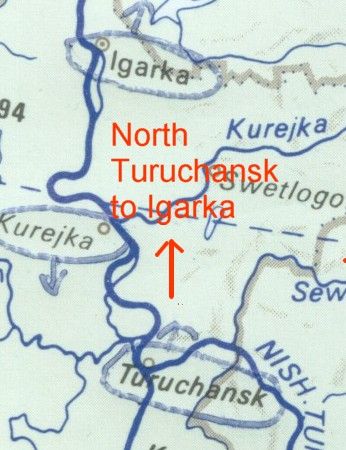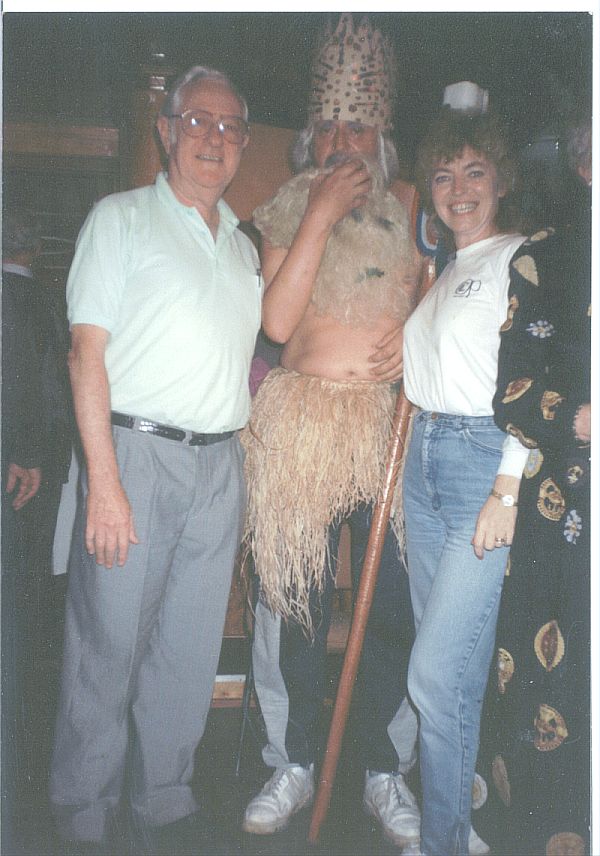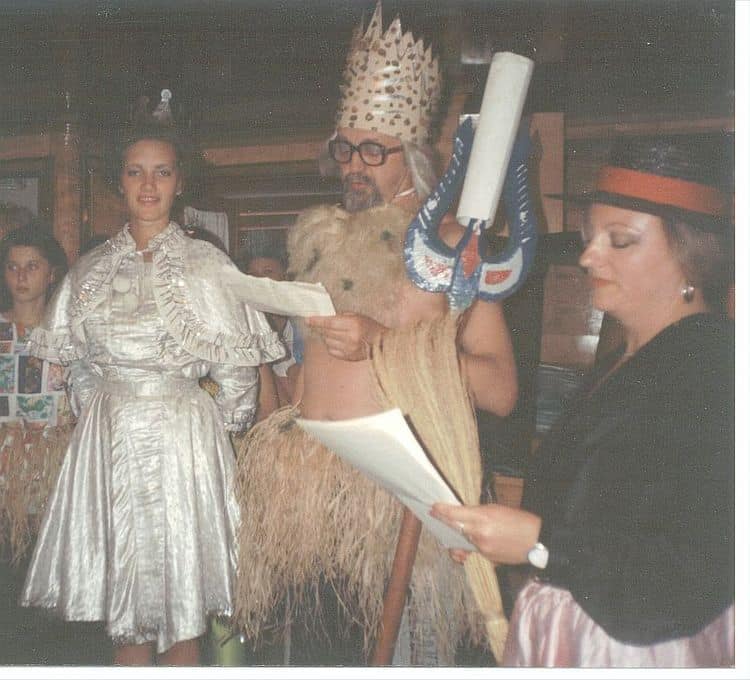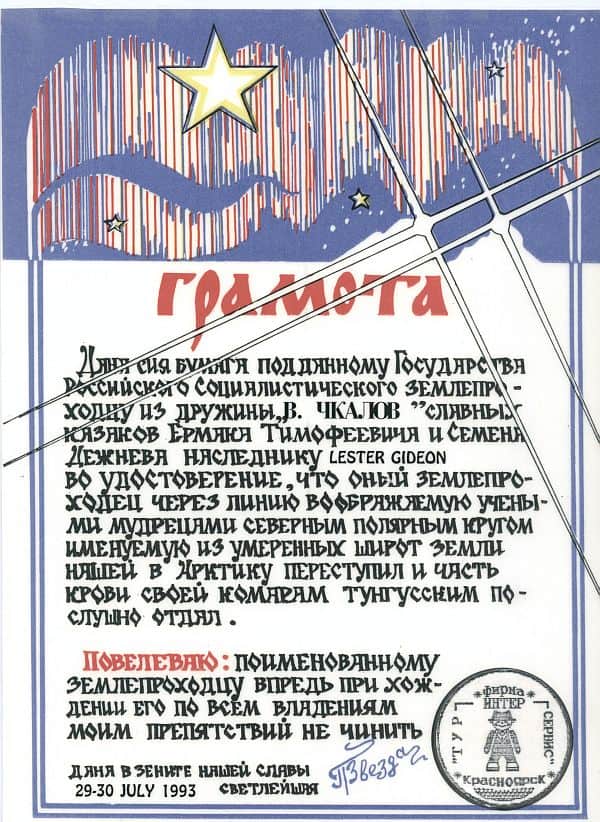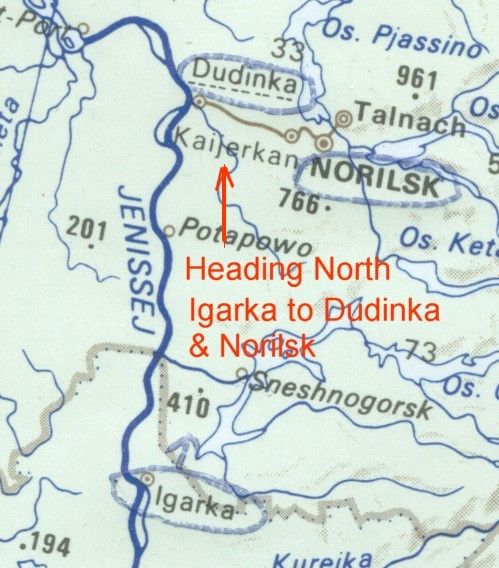The Yenisey River 2-Week Cruise

26 July to 30 July 1993
Green Forests, Beautiful Rivers, Stalin's Gulag Ruins,
Million Population Cities -- Siberia Had Them All
0900: Right to the minute the ship departed the dock. As we
learned, this ship's captain maintained his time schedules.
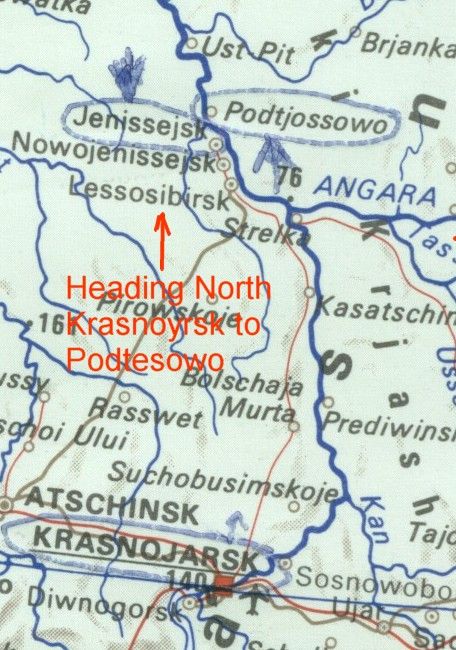
Remember my discussion about Rubles earlier? We were told that we could get
to a bank and exchange our pre-1993 money for new 1993 bills? We are glad that
we did it at the airport in Kaliningrad. There was no chance at all to do so
here. But, several of the Polish passengers were talking fast and getting themselves
upset at the word that we would be leaving at 0900. We heard that four passengers
left the ship about 0800 to look around the dock area, to go shopping and whatever.
Seems they must have thought we were going to stay in port Monday and leave
Tuesday, because we were one day late in arriving. They did not return before
we left the dock, so they must get to the ship downstream somewhere.
At this point I should mention that aboard the ship, we received 1000 Rubles
for each US$1.00. So, it was easy to figure costs of items to US$. Just move
the decimal on the Rubles 3 places to the left. We bought bottles of cognac
for 3100 Rubles, and champagne for 2800 Rubles ($3.10, $2.80).
0900-1805: We began our cruise downstream. I made note of the
mile-markers (in Kilometers) as we passed and clocked the time between them.
I calculated we were moving, ship's speed plus the river's current, at 28 Km
per hour. That was about 17 miles per hour. It was really a smooth, peaceful
cruise. The temperature outside was in the 80's, but the air-conditioning kept
our cabin cool.
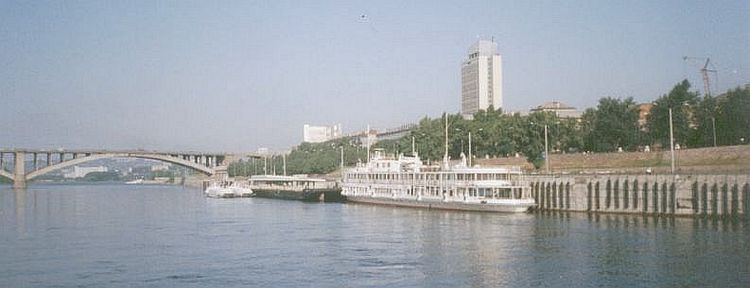
We are underway from the dock at Krasnoyarsk, with a ship similar to ours shown here
We had a very good cabin location with two large windows. All other cabins aft
of us had only one large window. Those on the lower decks had small windows
or round portholes.
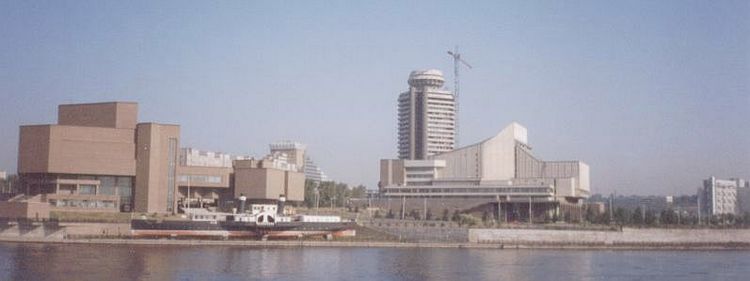
View of the large and beautiful Maritime Museum on the river's edge, Krasnoyarsk
We were able to get the feel of what the ship had to offer. There was a music
room just forward of us with a baby grand piano. The room was painted all in
white and had windows all around for a view of where we were going. Above our
cabin, was the main dining room. There were two meal sittings to accommodate
everyone.
Below us was a video theater. It had a VCR, a large TV set and about 40 chairs.
Forward of that in a large area was the night club, where we went for dancing
and drinking. On our deck in the aft section was a nice reading library; but
no books.
There were two aft open decks. The one on our deck level was covered and provided
a nice place for disco dancing. The upper open deck was much larger, and where
the crew presented their shows.
There were no lifeboat drills. There were full instructions in Russian along
with life-vests in each cabin.
We had to walk about 200 meters aft to the toilets and showers. The toilets
had no seats (as we know them). There was the usual harsh toilet paper the first
day out. When that was gone, there was no more for three days. By the first
night the toilet areas smelt like ???! And, our clothes that we wore to them
also smelt like ???. We discovered the toilets on the deck above us did not
get as much use, always had paper, still no seats, and did not smell. We used
those.
As we traveled this first day, we found lots of good information. Most important
was that Krasnoyarsk was until two years ago a closed city to anyone not Russian.
Only Russians were allowed aboard this cruise ship. We passed the super-secret
double-fenced highly guarded atomic plants located just north of Krasnoyarsk
on the east side of the river.
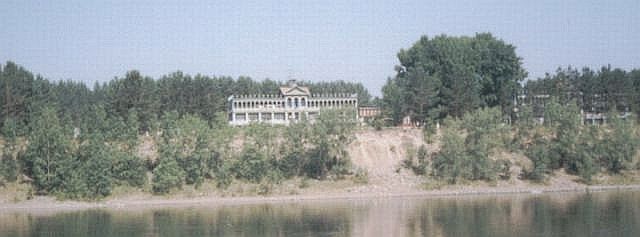
A view from the ship as we cruise downstream (north)

Another view, showing a large concentration of homes of those working in the forests and lumbering

More of the same, on the west side of the river, taken from our cabin
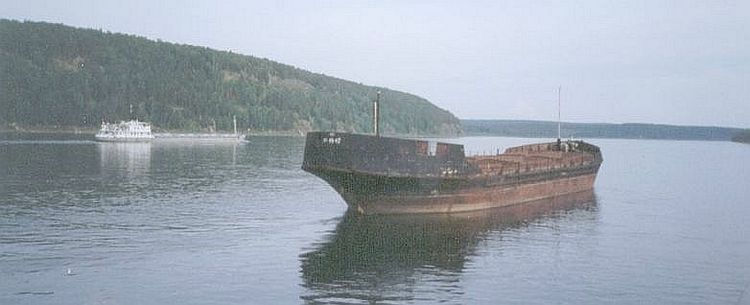
A rusting hulk, foreground, with a modern tug pushing its load in the
background
Last year, 1992, the cruises were open only to Polish persons. This year 1993,
was the first time ever a person from the west was allowed to go. There were
three USA passport holders aboard.
Except for the toilet problem, this was a very good cruise. It was as advertised,
and was well worth the US$350.00, each, that we paid for it.
1805: After a downstream run of about 140 Kilometers, we dropped
anchor and watched as the crew strung an extended gangplank from the ship to
shore. (See the photo of the ship.)
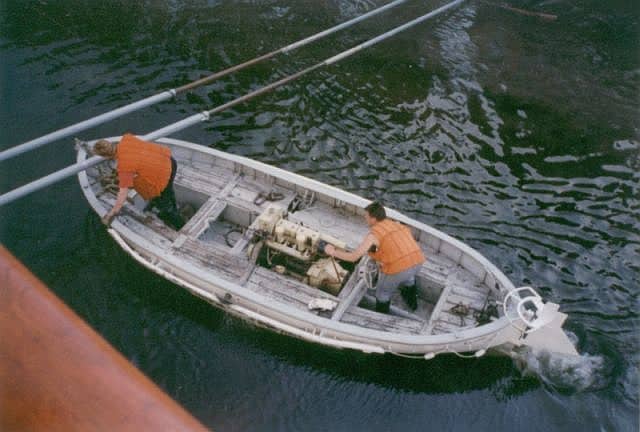
First they string the runners
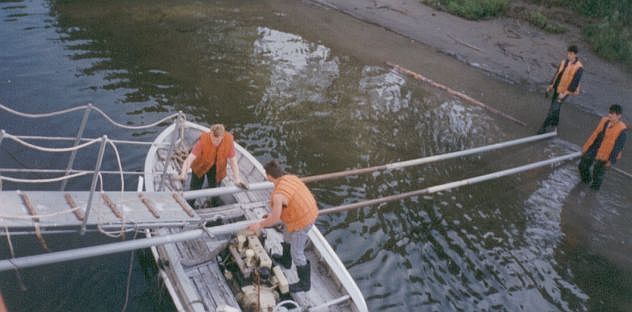
Then they set the planks for the footings
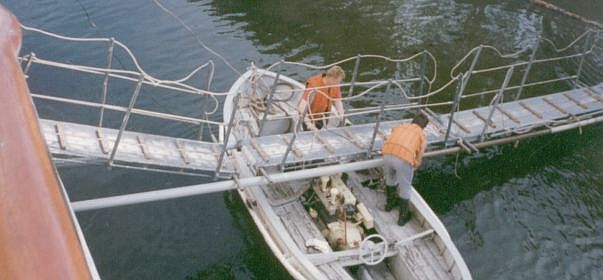
Continuing, making sure all is correct
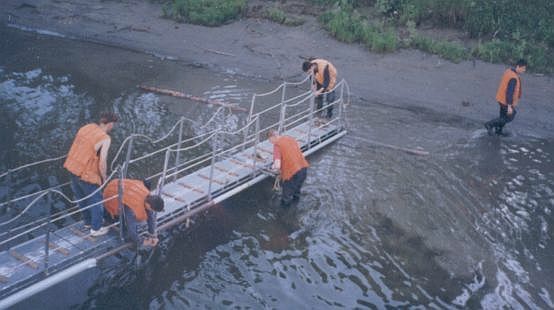
Final touches

Lester gets off, carefully
This was considered a "Green Stop." We spent the night there. There were two
reasons for the overnight stop. First, the river becomes very narrow as it passes
through a gorge just ahead, and passing it can only be done in daytime. Second,
the stunning beauty of the scenery would be missed if not seen during the daylight
hours. We went ashore for a short walk toward a waterfall.
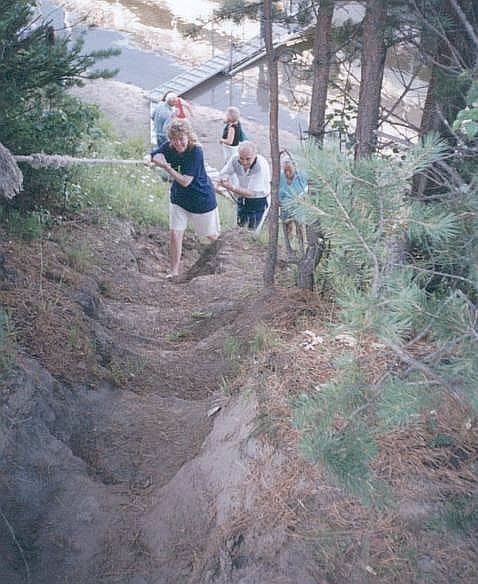
Danuta climbing up the side of the hill from the ship at the "Green Stop" area
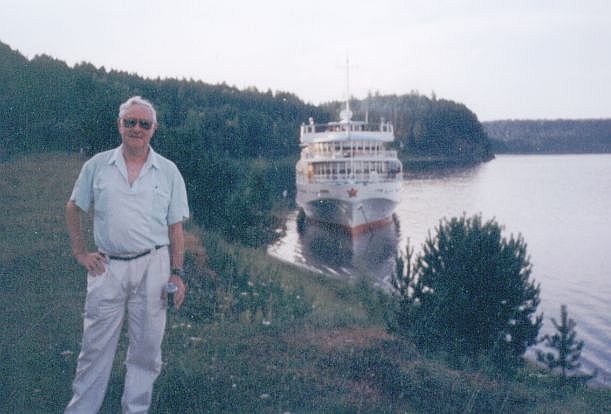
Lester on the hill, looking back at the ship at anchor
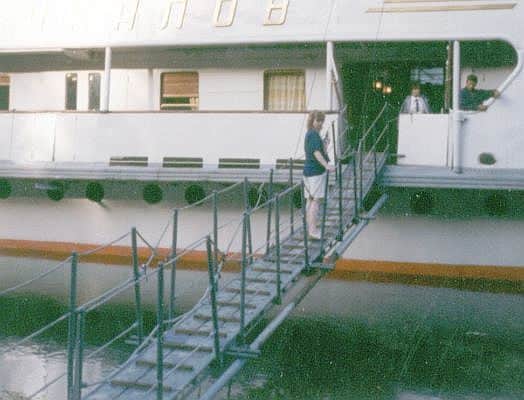
Danuta returning to the ship
2350 to Tuesday, 27 July-0100: We partied, danced up a storm
with some good rock and roll music, and shared our champagne with four fellow
passengers in the nightclub. I figured (quite wrongly) that if we provided the
first bottle of champagne for everyone, then each of them in turn would furnish
a round of drinks. Finally, one man figured that I wasn't going to buy anymore,
so he bought a bottle of cognac and passed it around. We left the dance early,
since we were still tired from the previous three days of travel. The nightclub
opened at 2300 hours and closed no earlier than 0500 next morning. There was
much vodka, champagne and cognac drinking. There was very little beer available.
The beer came from Holland.
Tuesday, 27 July-0730: This was our daily wake up time. It
started with a musical note blaring over the cabin's loud speaker, which we
could turn off. However, if we did turn it off, we would hear the neighbors'.
By the way the cabin walls were paper thin, and we could hear just about anything
above a whisper from our neighbors; and they, from us.
0800: Time for our first sitting at the restaurant. Our breakfast
was just about the same every day. There was a large kettle for us to pour ourselves
either tea or coffee with milk. Most days we had three slices of cheese or sausage
or cold roast beef. On the same plate were cucumbers, and occasionally quartered
slices of tomatoes. There was a large bowl filled with great tasting wheat bread.
We were served individual bowls of farina-like or wheat germ-like warm cereals.
0900: Precisely on time, the crew removed the gangplank, and
pulled the ship away from shore by slowly retrieving the anchor chain. We were
on our way through the beautiful gorge I mention above. There were sheer rock
cliffs rising about 200 feet, topped off by the regular stand of pine trees.
Green Peace and forest lovers would love this area. As far as you could see,
up and down the river, as well as inland, there was a continuous range of forests,
green and not bothered by humans. Even the islands within the river were fully
green with trees and shrubbery. The river was at least 200 meters wide at the
narrowest point and 2000 meters at the widest. It was very smooth.

View along the river near Podtesowo
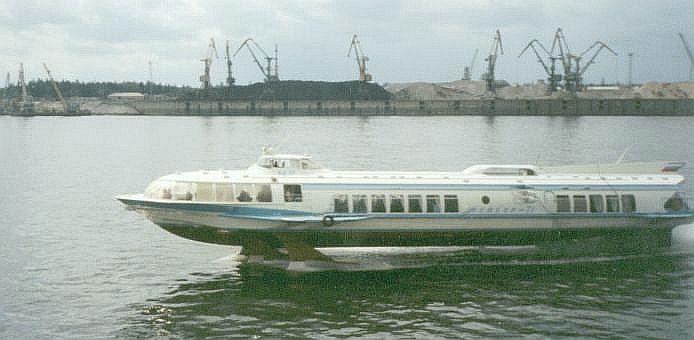
One of the many hydrofoils we see along the river
Hydrofoils, like the one we took from Gdansk to Kaliningrad, went up and down
the river stopping at small villages, like interurban buses on highways. After
the first 300 kilometers from Krasnoyarsk, there were no more roads, paved or
gravel, and the hydrofoil was the major way of travel.
There were other ships similar to our cruise ship, but smaller, that traveled
the same route as our ship. They might be considered the same as express buses.
They took a full week to go one way, stopping at major, larger communities along
the way. The whole system was well run. It operated like (for instance) Delta
Airlines; You fly between major city hubs, then take small commuter planes to
close by areas.

Lots of cranes for loading and moving timber at the docks at Podtesowo

Barges waiting their turn for loading timber
After we were underway, the small souvenir store opened. We purchased maps,
a large wall map of the river region, booklets, and postcards. The cost was
about 2000 Rubles (move the decimal three places comes to $2.00) a really great
bargain. At many points along the river, we could see signs of major military
activity. Helicopters flying, large phased-array type radar antennae.
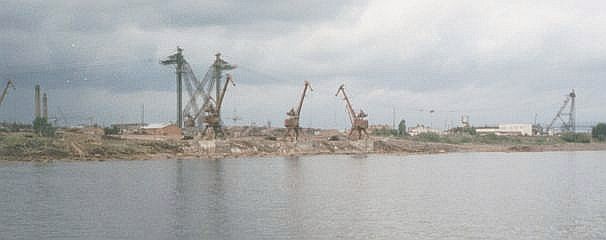
Large "A" frames help move the timber aroung the bay area
1600-2000: We tied up to the floating dock at the small town
of Podtesowo. There were a large ship building facility and ship maintenance
yards at this location. Most of the river boats are maintained here. Also, at
this point we picked up more ships hotel crew members. The ship also took on
more Russians to be passengers, to fill the yet vacant cabins.
The housing here was mainly large two story apartment buildings with about eight
or ten family units. They were constructed of timber, much like log cabins.
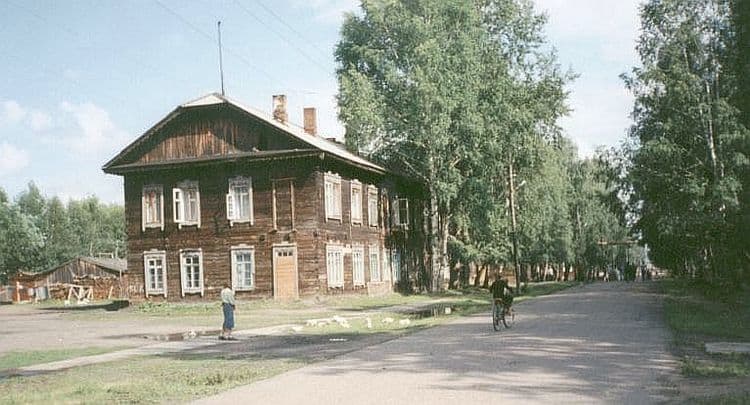
View inside the town of Podtesowo
We looked inside many stores that were open. There was a noticeable lack of
large varieties of fresh food products. There were plenty of canned foods, but
not much variety in them either. The meats that we saw were full of fat, very
little red showing. We purchase some candy and snack foods for 2495 Rubles.
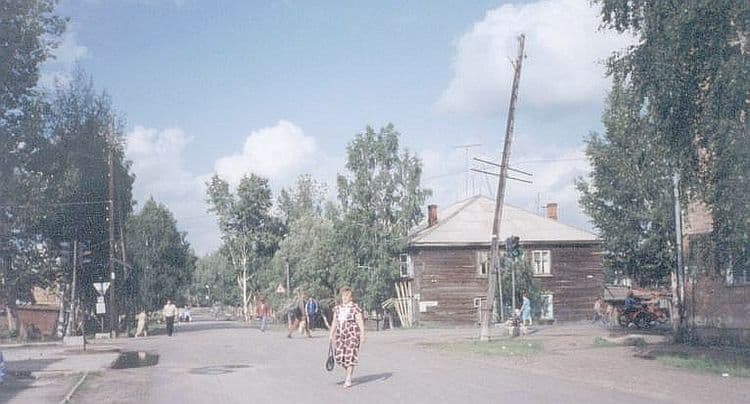
Danuta at the main interstion within the town of Podtesowo
None of the stores had their lights on, though it was difficult to see in some.
These villages had power lines coming from the dam just upstream from Krasnoyarsk.
Those further down stream, had diesel engines driven generators. The weather
continued to be warm, and the sun continued to shine. The sun was setting now
about 2300 and rising about 0300.
Oh, yes. There was very little vehicular traffic in this town. At the intersection
of two main streets, however, there was a traffic signal.
2000: Precisely on time, the lines were thrown clear and the
ship pulled away from the dock. We slept that night while the ship was underway.
The ride was absolutely smooth, you would never know that you were on a moving
ship. We compared this to the pitch and roll we experienced on the cruise ships
in the Caribbean and Pacific. During the night there were rain and heavy fog
on the river. The weather turned cold.
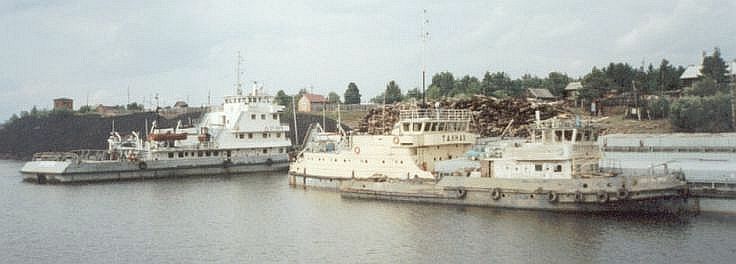
Part of the shipyard at Podtesowo

As we leave Podtesowo we pass these large areas filled with timber awaiting transport
Wednesday, 28 July-0950-1200: We arrived at the floating dock
at Worogowo. This was the first of the many villages we saw that were on high
plateaus, about 100 feet above the river. In spring as the snows melted, the
river rose about 100 feet and those villages were right at river level. We had
to climb that 100 feet along a temporary dirt road. We walked along the main
roads, mud and slush, into this town. We took many photos of the wooden homes.
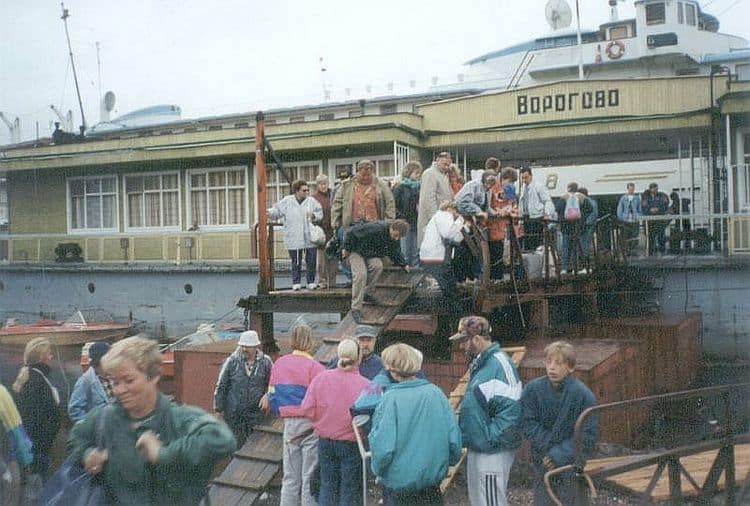
We arrive at the floating dock at Worogowo
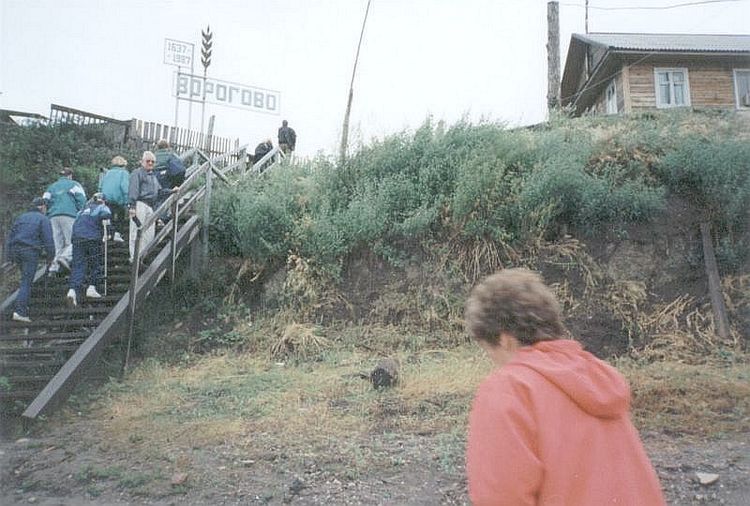
And, then climb the steps to the plateau (That is Lester looking back at the camera)
There was a small village museum that showed methods of lumbering and farming
in the past. Here was the first indication of the infamous "gulag" prison camps
set up by Stalin. We saw more in larger city museums in Dudinka and at the Gulag
that we visited near the mouth of the Jermakowo River. (More later)
We purchased an .5 liter bottle of 100 proof North Korean Vodka for 450 Rubles
(45 cents). Danuta bought a can of sardines for 100 Rubles. I bought Russian
beer for 500 Rubles, and some cookies for 100 Rubles.
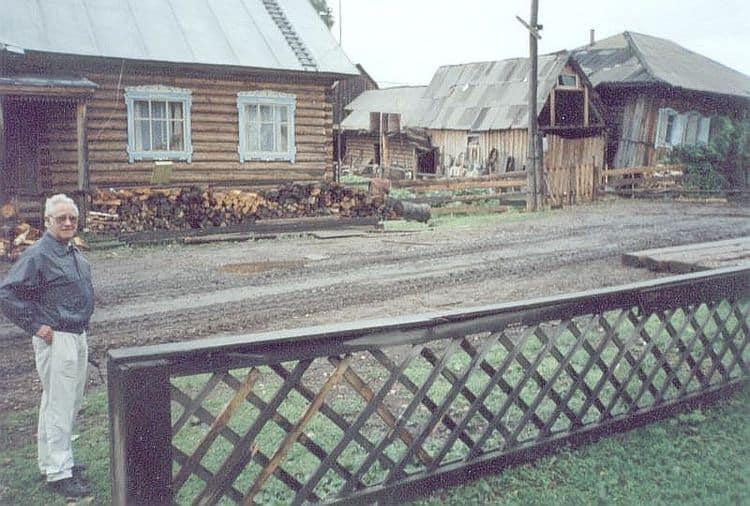
Lester standing near the main road running through the town of Worogowo
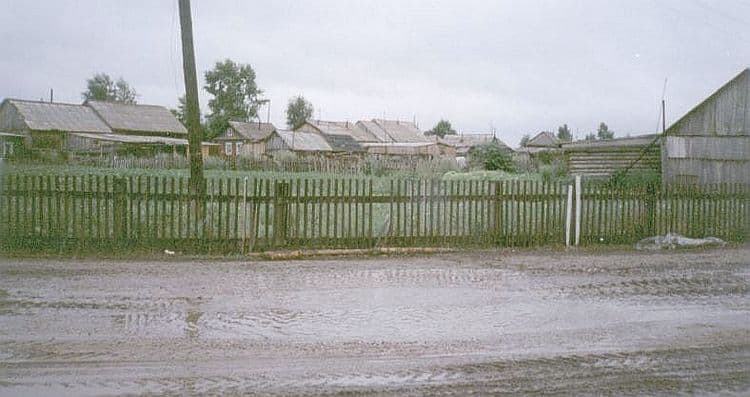
Another view inside Worogowo
Our shoes were muddy, my pants legs were muddy, so Danuta did some washing in
the ship's laundry room. There was a Russian spin type washing machine. In the
same room was a large bathtub, which was used as a wash tub for clothes.
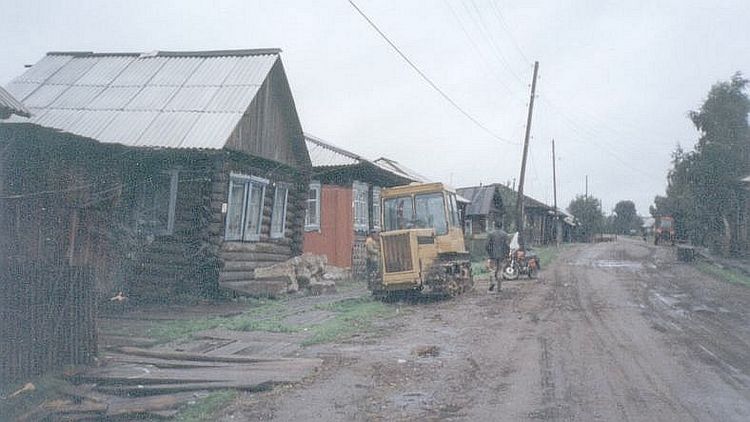
Another view inside Worogowo

Danuta on the street in Worogowo
1200: Again, right on schedule we pulled away from the floating
dock, and proceeded downstream.
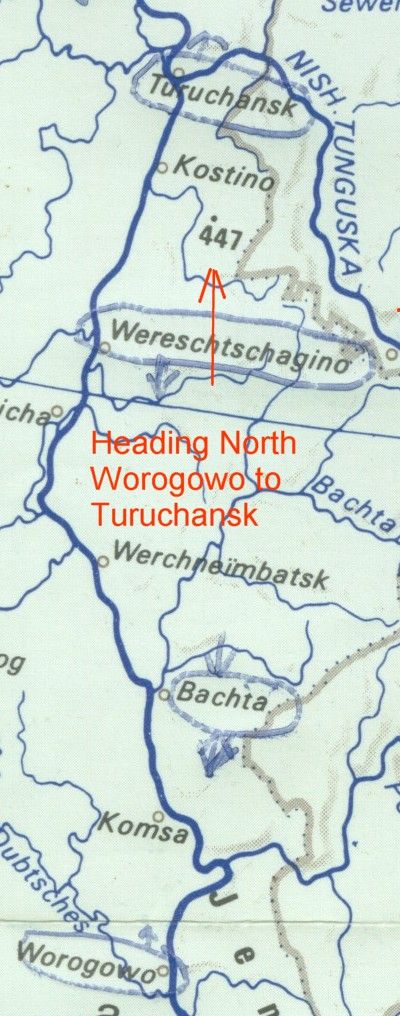
1300: Now for lunch. This was our biggest meal of the day.
It always started with soup, which was served in a large bowl from which we
served ourselves. These soups were excellent (my opinion, since I am a soup
for lunch lover). The soups varied each day. They contained either meat or fish,
and either mixed vegetable or potatoes or rice. Each person had a glass of fruit
juice. These juices were made by adding water to fresh plums, or other fruits
and boiling for a few moments. After cooling they were poured with the remains
of the fruit into glasses. They were really tasty. Our bread bowl was filled
with wheat bread. There was always an individual salad containing pickles or
cucumbers and/or tomatoes sprinkled with dill or other fresh spices.
The main course was either milled (ground) meat or fish; served with either
rice, or cooked wheat grain or mashed potatoes (no gravy). Sometimes we were
served beef stroganoff with mashed potatoes. For what we had paid for the trip,
these meals were not bad. We were told by one of the ship's staff, that we were
eating better than most villagers. Never-the-less, I kept thinking to myself
that if they wanted to entice Americans to take this cruise, they need ships
that have toilets/showers in the cabins, and serve solid instead of milled meat.
I would recommend this cruise to anyone willing to stand the problems. Again,
we passed beautiful scenery as we watched from our restaurant window.
1400: As we strolled the outer promenade deck of the ship,
we could see several ships heading upstream. We passed many going downstream.
Most consisted of two or three barges tied together and pushed by a huge flat
fronted tug boat. The cargo was mixed. There were cargo containers, automobiles,
trucks, timber (going both up and downstream), coal, sand or dirt and rocks.
There were round liquid cargo containers, gasoline and oil barges.
We also passed two large strange looking masses of timber being pulled and guided
by tugs. These logs were tied together, side by side, to a width of about 50
feet. Then, laying end to end, they were further tied together making a float
over 600 feet long, about the size of two football fields set end to end. There
was a tug in front pulling the lot with a tow line from the front set of logs.
A second tug at the rear moved from side to side, steered and kept the rear
of the mass in a straight line. This tug also provided a smooth curve as it
rounded a bend in the river. We had taken two photos of this event.
There were also many regular river cargo ships. At this point in the river,
there were only shallow draft vessels. It wasn't until we reached Igarka (later)
that we saw our first ocean going ships. As we went further north, we saw fewer
yet smaller hydrofoil ships.
2000: We ate supper every day at this time. The meal offered
little variance in selection. There was always the big pot of tea for self service.
There were individual plates of cucumber salads. The bowl of wheat bread was
full, again. The main course included a portion of fish or meat with mashed
potatoes or rice or cooked wheat grain. Desert consisted of sweet rolls (1)
or cookies (2) or small wrapped candies (2). There was plenty of food, but again
not much variety.
2300: We visited the disco (nightclub) again, but just watched
the dancing this time. The sun set about 2330 and rose about 0230.
Thursday, 29 July-a.m.: We followed the regular routine of
rising, breakfast and lunch this day, as we continued to cruise to our next
port. The views along the river were still beautiful. The water appeared clean.
The water was dark, and along the shore one could not see more than 2 feet down
to the sands or rocks on the bottom.
As we continued to head north, the land forms become almost flat with low rolling
hills. The river widened to about 1000 meters or more. Different types of Siberian
Fir or Pine trees were now seen in the forest.
Everywhere along the river were signs of logging or mining. At one point as
we came to Turukhansk, we saw mile after mile of stacked logs and giant log
handling cranes on rails that could remove the cargo from ships and move the
logs inland. There were also large overhead cables about 200 feet in the air
held up by 300 feet high steel 'A'-frames. These moved the logs parallel to
the river between piles.
Huge smokestacks indicated the location of the factories. Much of the timber
would be cut into building lumber. The left over materials were made into plywood.
Wherever we walked in the many small villages along the river, there were large
wooden bins. They were filled with bark and other unusable portions of timber.
The local people used this for firewood.
Firewood was provided downstream to areas that were timber scarce, by just letting
logs float downstream during the high water level in the spring. The villagers
grabbed the logs as they passed, pulled them onto shore where they become stranded
as the water level receded. These logs dried out during the summer. In the fall,
they were cut and split into proper size and stacked away for use during the
harsh winters.

1630-2000: We arrived at the floating dock, climbed the 100
foot cliffs to and visited the larger village of Turukhansk. This village had
many government as well as small private stores. The government buildings were
well constructed of concrete and steel. There was plenty of heat inside. This
village was just south of the Arctic Circle, and the rain, fog, and cool weather
continued for the first part of the visit. Then it cleared up and the weather
did get a little warmer. However, the roads, were really muddy.
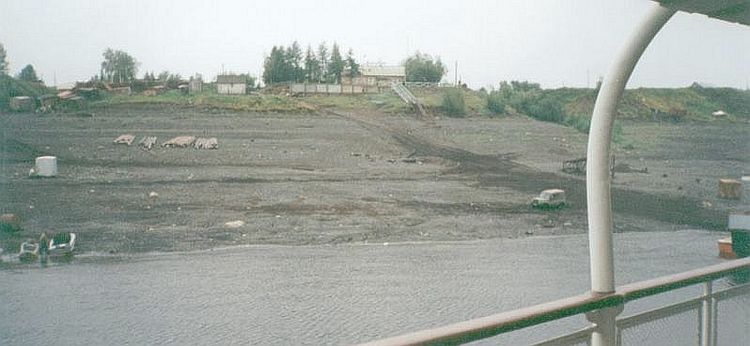
Pulling into Turukhansk

View of the shoreline at Turukhansk
We walked quite a distance in this town, along the wooden sidewalks. At one
point Danuta suggested we look inside one of the homes to see how the people
lived. She hailed to a woman standing outside her home's entrance, and in
Russian asked if we could see her home.
I felt really strange as I followed them into the outer entrance room. I was
really surprised to see how well they did live. The inside was well furnished
with beds, chairs, couch, wood burning fireplace and stove, and carpeting on
the floors. They had a large color television. We later found out that about
90 percent of the homes in Siberian had TV, and each community had a satellite
dish to download signals from Moscow. It was warm inside, but chilly outside.
We took off our shoes and walked in our stocking feet around the room. We thanked
the woman, her husband and three kids for showing us their home and we left.
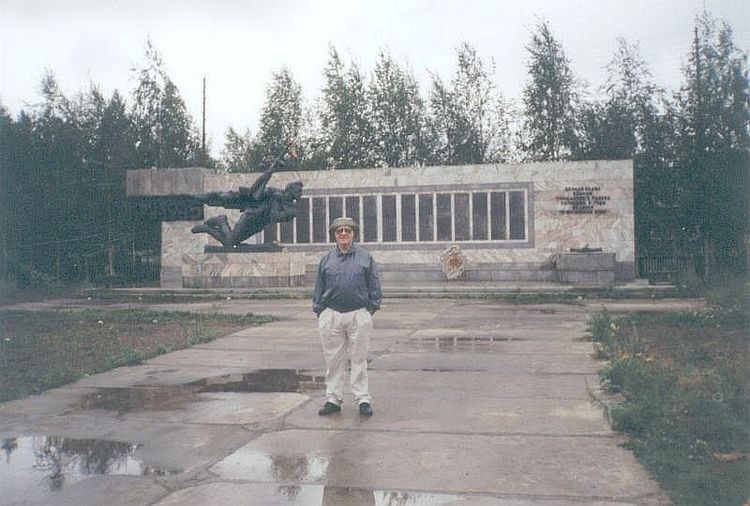
Lester standing in front of a memorial to the brave workers in Siberia
Crossing the streets was messy. Vehicular traffic was heavy at times. It consisted
of sidecar-mounted motorcycles, large heavy duty 4-wheel drive tractor like
trucks, and jeep-like four passenger cars. The latter vehicles were all government
owned brown or camouflaged colored.
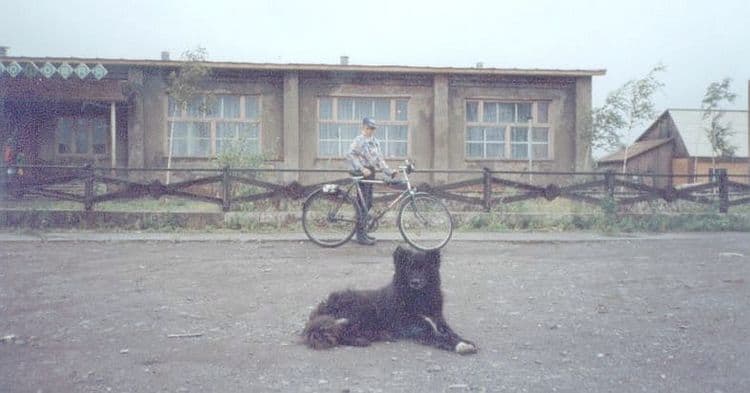
Siberian Huskey, a great family dog

Another street scene. Note that it had been raining
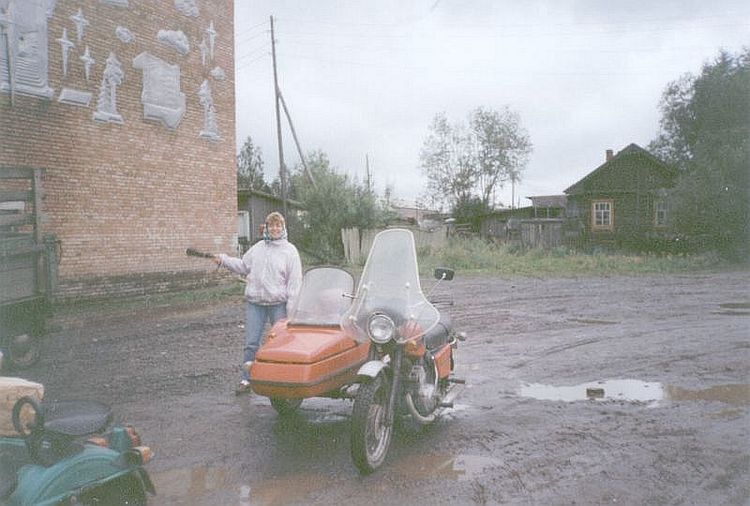
Danuta standing next to the most popular means of travel around Turukhansk and other Yenisey River towns
We went on a shopping splurge in this village. We bought a meat grinder to
take to California for 505 Rubles (50.5 cents), and for Gdansk Danuta paid
500 Rubles (50 cents) for a very well made, aluminum kerosene burning portable
stove. As we took all this back aboard the ship, I kept wondering just how
were we going to get it home. Danuta told me: "No problem." And, while bulky,
it turned out to be no problem.
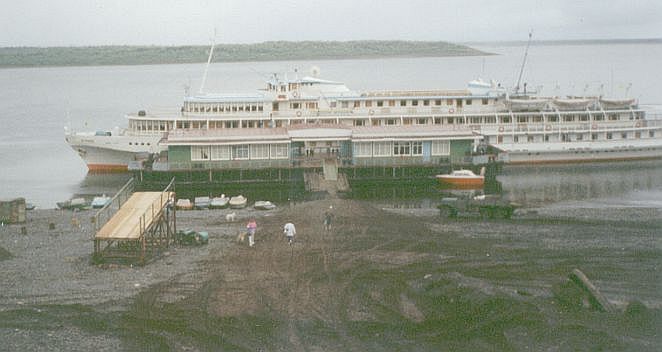
Our ship at the shoreline at Turukhansk
2000: Right on schedule we pulled away from the dock. As we
continued downstream, in a northerly direction toward Dudinka, we were to cross
the Arctic Circle about 1 a.m. Meanwhile, we were all invited by King Neptune
to a "crossing the line" party to be held in the main dining room about 9 p.m.
It was a little before the crossing of the Artic Circle, but held right on time.
It was a very good party. The ship's Russian social director read from a script
in Russian, which was translated into Polish by one of our Polish escorts. King
Neptune was one of the men who drank our champagne at the nightclub.
Most of the 20 or so participants were passengers. I could only pretend to understand
what was happening. It was great fun for all. It ended with the captain's personal
representative giving everyone a certificate from King Neptune attesting to
the holder's crossing of the Arctic Circle.
Friday, 30 July-0000: We began to party in the nightclub. We
awaited the arrival of our King Neptune. By now he had changed clothes to more
civil dressing. At midnight, Danuta and I went on deck and took photos of each
other with the redness of the midnight sun glowing in the background. This night
the sunset was about 2345, and the sunrise about 0130. We actually crossed the
Arctic Circle at about 0100. As you will read later, we did see blue sky all
night. However, since it was late July, we were not able to see the sun go from
west to east.
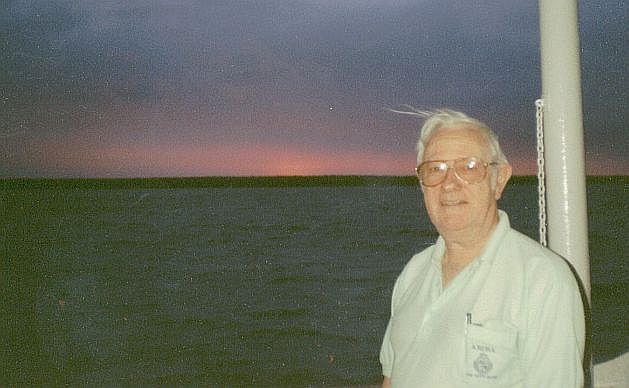
Lester at the railing of the ship at midnight in July at the Arctic Circle
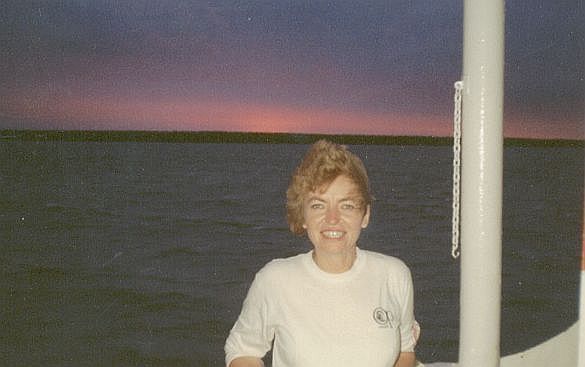
Danuta at the Arctic Circle at midnight in July
0840-1500: We visited Igarka. This was a larger city, with
many docking areas to handle large oceangoing vessels. There were many huge
cranes to handle cargo containers, various types of other cranes and piping
lines for bulk materials. We saw the river barges being unloaded with goods
to be later loaded onto big ships, and vice versa.

We walked up steps made of wood this time, to the plateau area where there were
many concrete buildings. We walked as a group up a sloping hill for about 1
kilometer to a bus stop. All the time, we were viewing the historical elements
of this city's buildings. We took a bus, but had no 10 Ruble tickets, nor did
we pay. How could we? We were pushed in like sardines in a can. The money box
was out of reach.
After a 5-kilometer ride past huge outdoor storage areas filled with plywood
and lumber products we came to another bus stop. We all got off and were led
to a small building.
Inside was another nice, well-organized museum on the life of animals and people
in northern Siberia. There was a curator who explained everything in Russian.
Again, our tour leader translated it for the Polish people. Nothing was in English.
However, I could easily read many of the Cyrillic characters, and read the English
derived words. Anyway, it was well worth the bus ride.
At the end of the tour, we paused for another brief lecture on the "ice museum"
that we were about to enter. The woodwork in this area was beautiful, well polished
and laid out.
The curator unlocked a huge wooden door and we went into the lighted hole in
the ground. The 50 or so steps down into the lower chamber were of concrete.
We went into an area where we could get a firsthand look at the permafrost found
throughout Siberia. There were layers of ice set between layers of stone. It
was an awesome sight. In one of the rear chambers was a display of dinosaur
bones and other artifacts recovered in these diggings.
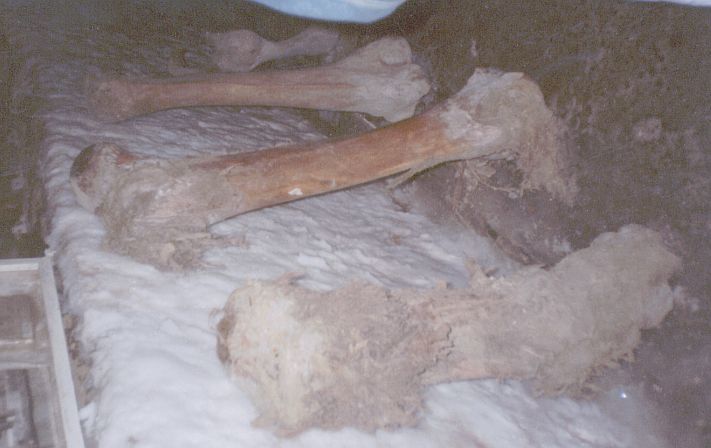
Dinosaur bones as shwon in the Igarka museum
The curator explained the method of constructing the foundations for the huge
6 to 13 story apartment buildings that were found throughout Igarka, Dudinka
and Norilsk. To lay a foundation as found normally in the south, would result
in the heat of the building flowing through the concrete floor down into the
ground. This heat would be enough to melt the ice within the permafrost. As
the ice melted, the cavities would be empty voids allowing the rock and dirt
to settle downwards. This collapsing of the ground would create an unstable
foundation for the buildings and they could topple or collapse.
To prevent this problem, deep holes were drilled into the ground until bedrock
was struck. These holes were filled with steel and concrete and became pilings
sticking out of the earth. The first floorings were laid on top of these pilings,
allowing a 3 or 4 foot air space between the ground and the first part of building
construction. In this manner, the heat of the buildings was not able to penetrate
into the permafrost, thereby preserving its supportive strength.
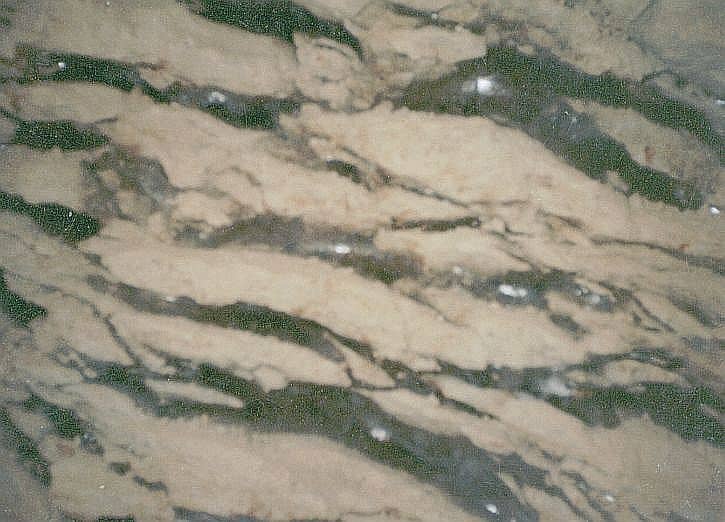
Section showing the permafrost layers of soil, rock and ice
After leaving the museum, we were escorted 100 feet to a building loaded with
handcrafted items that were for sale. There were wooden carvings of people,
fish and animals. There were the traditional hand painted wooden figures and
eggs. There were hand woven garments and cloth. There were leather goods of
all types. The prices looked like a great bargain. But, we were told the numbers
were in US$, NOT Russian Rubles. So, here was our very first sight of a Russian
Tourist Trap store.
After this we were on our own. The tour leader told us that we should take any
bus and go to the new housing building blocks to see for ourselves the construction
method. We should also do some shopping in their local stores.
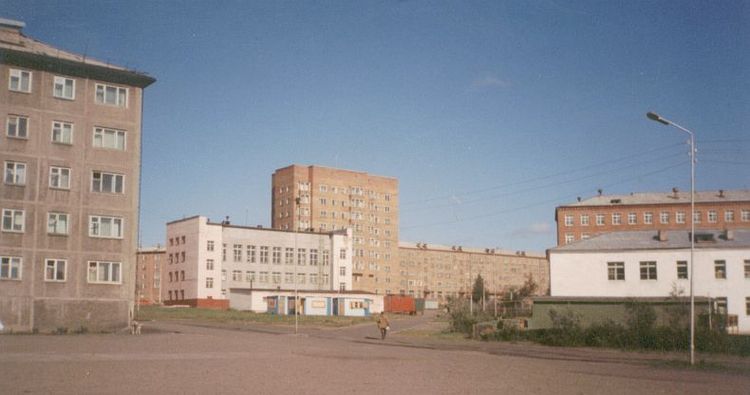
View in Igarka showing the large newer apartment buildings
There was the usual lack of variety in the stores we visited. In most, there
was the usual number of workers. There was always one at the cash register.
There were usually two to serve you, and another to wrap your item. The normal
procedure was for you to look on the shelves behind the clerks or in the glass
topped counters in front to select what you might like to buy. They would show
you what you requested when your turn in line came.
If you want to buy the item, the clerk would write out a ticket, which you take
to the cashier and pay the amount noted. The cashier stamps and/or tears a piece
off for you to take back to the pick up point. You get your merchandise after
the clerk verifies that you had paid.
As we walked throughout the housing area, we noted that the buildings were built
on pilings, not directly on the ground. We spent 400 Rubles on miscellaneous
snacks and took a bus back to the bus stop on the main street that goes to the
harbor.
We walked down the hill stopping at many stores to see what was available. There
were quite a few independent merchants selling audio tapes, clothing, snack
foods and soft drinks. One large meat store had more meat varieties than we
had seen so far.

Last look back at Igarka and its shoreline docking from the ship
1500: Right on schedule we pulled away from the dock and proceeded
downstream toward Dudinka. Again, we watched the landscape from our cabin, from
the open deck as we walked around, and from our restaurant seat. There was now
a noticeable lack of high trees. The river seemed to be running slower. The
reason is the venturi effect, the water runs slower as the river gets wider.
This was truly one of the most beautiful areas of the world.
 Return to Introduction |
 Return to Part 1 |
 Continue on now to Part 3 |












































